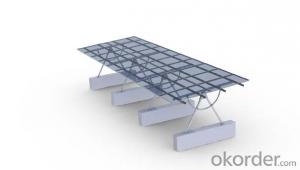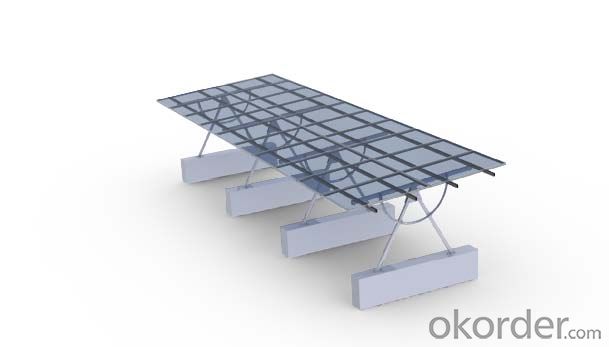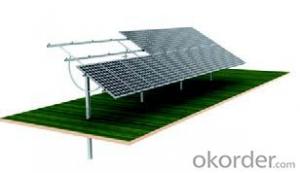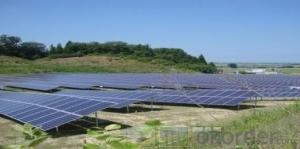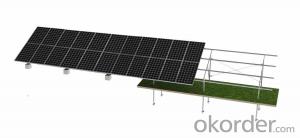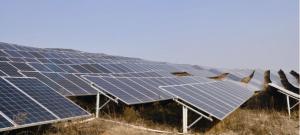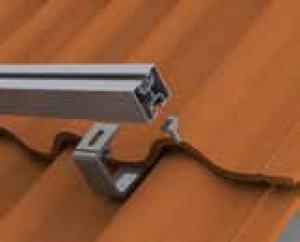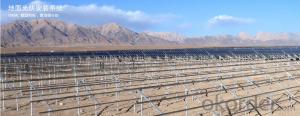Infusion Solar Energy Systems - Double Pile Manual Solar Mounting System
- Loading Port:
- China Main Port
- Payment Terms:
- TT OR LC
- Min Order Qty:
- -
- Supply Capability:
- -
OKorder Service Pledge
OKorder Financial Service
You Might Also Like
Packaging & Delivery
Packaging Detail:Normal package seaworthy
Delivery Detail:15 days
Specifications
Easy installation Competitive price TUV&SGS test report & CSA certification 15-warranty
Specifications
1) Super smooth beautiful appearance,outstanding quality,large supply.
2) Available in customized surface finishes.
3) Well machined,for example,cutting,drilling and milling with excellent tolerance.
4) Meet with customer’s designs and supply you best price.
5)Usages:Supply for solar panel modules.
Technical characteristics
Installation site:
ground,hillside,and grassland
Installation angle
it is based on customers’ requirements
Installation height
it is basedon customers’ requirements
Solar panel type; with or without frame
Components arrangement :horizontal or vertical
Support track
aluminum alloy extrusion
Quality warranty
15 years
Advantages
1)Quick installation: with high degree of pre-installed rate, the system could be easily installed by using galvanized carbon steel rails for PV Stent, and specially designed connection parts of the PV bracket, which could reduce installation time and cost greatly.
2)Offer unmatched durability: with all structural components comprised of high class stainless steel and anodized aluminum alloy, it is designed for 25 years service life and backed by 15 years warranty.
3)Stand up to extreme weather: The SuninTek solar mount is designed to stand up to the extreme weather complied with the AS/NZ 1170 and other international structure load standard by the skilled engineer. The main support components also have been tested to guarantee its structure and load-carrying capacity.
4)Provide broad installation flexibility: These systems accommodate most commercially available framed solar panels , and they can scale easily from small to large, multi-megawatt installations.
5)Diversified Application: The PV mounting system produced can be adopted by various types of PV cells panels which you can find in the market. It can serve for both mini solar power system and huge plant with megawatt capability.
Main features
1. Installation cost savings.
2. Save installation time.
3. Increase the mechanical strength of solar energy mounting to ensure that wind requirements.
4. The outdoor for installation of solar energy.
5. Length can be customized according to customers.
6. Service life of up to 25 years.
7. Products through the international certification.
8. Stent material composition of the galvanized steel and aluminum.
9. 15 years system and structural guarantee.
10.Flexible post spacing withstands different wind & snow loads.
11. High quality material in Aluminium 6005-T5 and SUS 304.
12.Screws and nuts go with every components needed.
13.Mechanical calculation and reliability tested to ensure highest product quality.
- Q: What is the lifespan of solar energy inverters?
- Solar energy inverters can have varying lifespans due to factors such as the inverter's quality, usage, and maintenance. Generally, a solar energy inverter that is of high quality and properly maintained can last approximately 10 to 15 years. However, thanks to technological advancements and enhanced durability, certain inverters can endure for 20 years or even more. It is crucial to bear in mind that regular maintenance, including thorough cleaning and inspection, can assist in prolonging the inverter's lifespan. Furthermore, selecting a reputable brand and ensuring correct installation can also contribute to an extended lifespan for solar energy inverters.
- Q: Can solar energy systems be used in areas with high temperatures?
- Yes, solar energy systems can be used in areas with high temperatures. In fact, solar panels are designed to withstand and operate efficiently in a wide range of temperatures. While high temperatures can slightly affect the efficiency of solar panels, modern technologies and materials have been developed to minimize any negative impact. Additionally, solar energy systems can be optimized through proper installation and maintenance to ensure maximum performance in hot climates.
- Q: Can solar energy systems be used for powering industrial manufacturing plants?
- Yes, solar energy systems can be used for powering industrial manufacturing plants. With advancements in solar technology and the availability of large-scale solar panels, industrial manufacturing plants can harness solar power to meet their energy needs. This not only helps reduce reliance on fossil fuels but also contributes to cost savings and environmental sustainability in the long run.
- Q: Can solar energy systems be used in commercial buildings?
- Yes, solar energy systems can be used in commercial buildings. In fact, many businesses and organizations are increasingly adopting solar power to meet their energy needs. Solar panels can be installed on rooftops, parking lots, or other suitable areas of commercial buildings to generate clean and renewable energy. This helps reduce electricity costs, decrease carbon footprint, and promote sustainability in the commercial sector.
- Q: Are there any limitations to using solar energy for powering vehicles?
- Yes, there are limitations to using solar energy for powering vehicles. One major limitation is the dependence on sunlight, which means solar-powered vehicles may not be suitable for regions with limited sunlight or during nighttime. Additionally, solar panels are bulky and require a large surface area to generate enough energy, making it challenging to fit them on small vehicles. The efficiency of solar panels is also affected by factors like dust, dirt, and shading, which can reduce their effectiveness. Furthermore, the cost of solar panels and their storage systems can be relatively high, making the initial investment expensive.
- Q: How do solar energy systems contribute to energy independence?
- Solar energy systems contribute to energy independence by harnessing the power of the sun to generate electricity. By utilizing renewable energy sources, such as solar panels, we reduce our reliance on fossil fuels and foreign oil. This, in turn, decreases our vulnerability to fluctuations in oil prices and geopolitical tensions. Solar energy systems empower individuals, businesses, and even entire communities to generate their own clean and sustainable energy, reducing their dependence on the traditional energy grid and promoting self-sufficiency.
- Q: Can solar energy systems be installed in areas with extreme weather conditions?
- Solar energy systems can indeed be installed in regions with harsh weather conditions. Though extreme heat, cold, wind, or snow may potentially affect the efficiency of solar energy systems, modern solar technology has been engineered to endure such conditions. Solar panels are constructed using sturdy materials capable of withstanding high temperatures, freezing temperatures, and strong winds. Furthermore, solar panels undergo rigorous testing and certification to meet industry standards for durability and performance in various weather conditions. In areas with extreme heat, solar panels are designed to dissipate heat and maintain optimal efficiency. They are thoroughly tested to ensure they can sustain high temperatures without any damage or significant performance loss. Similarly, solar panels in areas with extreme cold are built to withstand freezing temperatures and can even generate electricity in snowy conditions. Some solar panels feature anti-reflective coatings to absorb more sunlight and expedite snow melting. Moreover, solar energy systems are commonly installed with robust mounting systems and structures capable of enduring strong winds or storms. These systems are engineered to ensure that solar panels remain securely attached to roofs or ground mounts, even in hurricane-prone or high-wind regions. Though the performance of solar energy systems may be slightly affected by extreme weather conditions, proper installation and design enable solar panels to still generate electricity and provide a dependable source of renewable energy in such areas. It is advisable to seek guidance from experienced solar installers or engineers who can evaluate the specific weather conditions of a given region and develop a solar energy system capable of withstanding those conditions.
- Q: Can a solar energy system be installed on a hotel or resort?
- Yes, a solar energy system can be installed on a hotel or resort. In fact, many hotels and resorts have already embraced solar technology as a way to reduce their carbon footprint, lower energy costs, and demonstrate their commitment to sustainability. Solar panels can be installed on the roof or open spaces of the property to harness renewable energy from the sun. This not only allows for self-sufficiency in electricity generation but also creates a positive image for the hotel or resort among environmentally-conscious guests.
- Q: How do solar energy systems affect electricity bills?
- Solar energy systems can significantly reduce electricity bills by generating free and clean energy from the sun. By harnessing sunlight to produce electricity, these systems offset the need to purchase electricity from the grid. Depending on the size and efficiency of the solar installation, electricity bills can be reduced by a significant amount or even eliminated entirely.
- Q: Can solar energy systems be used to power electric vehicles?
- Yes, solar energy systems can be used to power electric vehicles. Solar panels can be installed on the vehicle or on a charging station to harness sunlight and convert it into electricity, which can then be used to charge the vehicle's battery. This enables the vehicle to be charged using renewable energy, reducing reliance on fossil fuels and lowering carbon emissions.
Send your message to us
Infusion Solar Energy Systems - Double Pile Manual Solar Mounting System
- Loading Port:
- China Main Port
- Payment Terms:
- TT OR LC
- Min Order Qty:
- -
- Supply Capability:
- -
OKorder Service Pledge
OKorder Financial Service
Similar products
Hot products
Hot Searches
Related keywords
